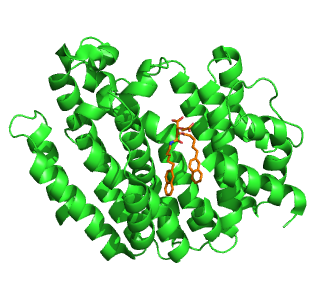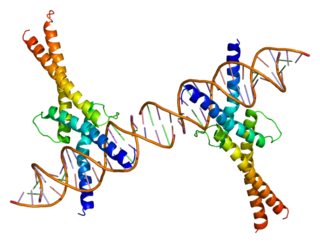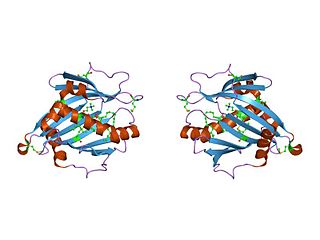The steroidogenic acute regulatory protein, commonly referred to as StAR (STARD1), is a transport protein that regulates cholesterol transfer within the mitochondria, which is the rate-limiting step in the production of steroid hormones. It is primarily present in steroid-producing cells, including theca cells and luteal cells in the ovary, Leydig cells in the testis and cell types in the adrenal cortex.
The liver X receptor (LXR) is a member of the nuclear receptor family of transcription factors and is closely related to nuclear receptors such as the PPARs, FXR and RXR. Liver X receptors (LXRs) are important regulators of cholesterol, fatty acid, and glucose homeostasis. LXRs were earlier classified as orphan nuclear receptors, however, upon discovery of endogenous oxysterols as ligands they were subsequently deorphanized.

Cholesterol 7 alpha-hydroxylase also known as cholesterol 7-alpha-monooxygenase or cytochrome P450 7A1 (CYP7A1) is an enzyme that in humans is encoded by the CYP7A1 gene which has an important role in cholesterol metabolism. It is a cytochrome P450 enzyme, which belongs to the oxidoreductase class, and converts cholesterol to 7-alpha-hydroxycholesterol, the first and rate limiting step in bile acid synthesis.

Hormone-sensitive lipase, also previously known as cholesteryl ester hydrolase (CEH), sometimes referred to as triacylglycerol lipase, is an enzyme that, in humans, is encoded by the LIPE gene.

Squalene synthase (SQS) or farnesyl-diphosphate:farnesyl-diphosphate farnesyl transferase is an enzyme localized to the membrane of the endoplasmic reticulum. SQS participates in the isoprenoid biosynthetic pathway, catalyzing a two-step reaction in which two identical molecules of farnesyl pyrophosphate (FPP) are converted into squalene, with the consumption of NADPH. Catalysis by SQS is the first committed step in sterol synthesis, since the squalene produced is converted exclusively into various sterols, such as cholesterol, via a complex, multi-step pathway. SQS belongs to squalene/phytoene synthase family of proteins.

Squalene monooxygenase is an enzyme that uses NADPH and molecular oxygen to oxidize squalene to 2,3-oxidosqualene. Squalene epoxidase catalyzes the first oxygenation step in sterol biosynthesis and is thought to be one of the rate-limiting enzymes in this pathway. In humans, squalene epoxidase is encoded by the SQLE gene. Several eukaryote genomes lack a squalene monooxygenase encoding gene, but instead encode an alternative squalene epoxidase that catalyzes the oxidation of squalene.

Sterol regulatory element-binding protein cleavage-activating protein, also known as SREBP cleavage-activating protein or SCAP is a protein that in humans is encoded by the SCAP gene.

Sterol regulatory element-binding transcription factor 1 (SREBF1) also known as sterol regulatory element-binding protein 1 (SREBP-1) is a protein that in humans is encoded by the SREBF1 gene.

ATP-binding cassette sub-family G member 5 is a protein that in humans is encoded by the ABCG5 gene.

ATP-binding cassette sub-family G member 8 is a protein that in humans is encoded by the ABCG8 gene.

ATP-binding cassette sub-family A member 7 is a protein that in humans is encoded by the ABCA7 gene.

1-acylglycerol-3-phosphate O-acyltransferase ABHD5 is an enzyme that in humans is encoded by the ABHD5 gene.

CYP8B1 also known as sterol 12-alpha-hydroxylase is a protein which in humans is encoded by the CYP8B1 gene.

START is a lipid-binding domain in StAR, HD-ZIP and signalling proteins. The archetypical domain is found in StAR, a mitochondrial protein that is synthesized in steroid-producing cells. StAR initiates steroid production by mediating the delivery of cholesterol to the first enzyme in steroidogenic pathway. The START domain is critical for this activity, perhaps through the binding of cholesterol. Following the discovery of StAR, 15 START-domain-containing proteins were subsequently identified in vertebrates as well as other that are related.

Phosphatidylcholine transfer protein (PCTP) also known as StAR-related lipid transfer domain protein 2 (STARD2) is a specific intracellular phospholipid binding protein that can transfer phosphatidylcholine between different membranes in the cytosol.

StAR-related lipid transfer domain protein 8 (STARD8) also known as deleted in liver cancer 3 protein (DLC-3) is a protein that in humans is encoded by the STARD8 gene and is a member of the DLC family.

Oxysterol binding protein-like 9 is a protein that in humans is encoded by the OSBPL9 gene.

StAR-related lipid transfer protein 4 (STARD4) is a soluble protein involved in cholesterol transport. It can transfer up to 7 sterol molecules per minute between artificial membranes.

Methylsterol monooxygenase 1 is a protein that in humans is encoded by the MSMO1 gene.

StAR related lipid transfer domain containing 3(STARD3) is a protein that in humans is encoded by the STARD3 gene. STARD3 also known as metastatic lymph node 64 protein (MLN64) is a late endosomal integral membrane protein involved in cholesterol transport. STARD3 creates membrane contact sites between the endoplasmic reticulum and late endosomes where it moves cholesterol.


















